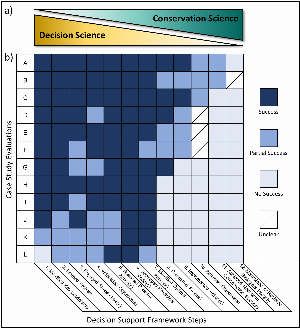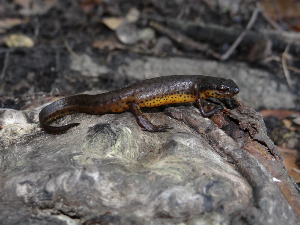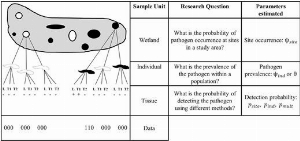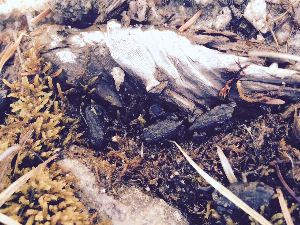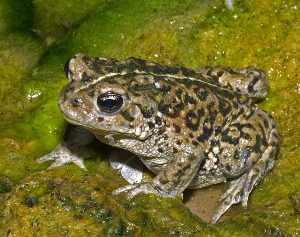Search ARMI Database
Search term(s)
Contribution Number
Search Results
21 record(s) found.
Papers & Reports Preparing for a Bsal invasion into North America has improved multi-sector readiness
Papers & Reports Matching decision support modeling frameworks to disease emergence stages
Papers & Reports Preparing for a Bsal invasion into North America has improved multi-sector readiness
Papers & Reports Inferring pathogen presence when sample misclassification and partial observation occur
2. Here, we develop a Bayesian hierarchal framework that accommodates false negative, false positive, and uncertain detections to improve inference related to the occupancy of a pathogen. We apply our modeling framework to a case study of the fungal pathogen Pseudogymnoascus destructans (Pd) identified in Texas bats at the invasion front of white-nose syndrome. To improve future surveillance programs, we provide guidance on sample sizes required to be 95% certain a target organism is absent from a site.
3. We found that the presence of uncertain detections increased the variability of resulting posterior probability distributions of pathogen occurrence, and that our estimates of required sample size were very sensitive to prior information about pathogen occupancy, pathogen prevalence, and diagnostic test specificity. In the Pd case study, we found that the posterior probability of occupancy was very low in 2018, but occupancy probability approached 1 in 2020, reflecting increasing prior probabilities of occupancy and prevalence elicited from the site manager.
4. Our modeling framework provides the user a posterior probability distribution of pathogen occurrence, which allows for subjective interpretation by the decision-maker. To help readers apply and use the methods we developed, we provide an interactive?RShiny?app?that generates target species?occupancy estimation and sample size estimates to make these methods more accessible?to the scientific community (https://rmummah.shinyapps.io/ambigDetect_sampleSize).?This modeling framework and sample size guide may be useful for improving inferences from molecular surveillance data about emerging pathogens, non-native invasive species, and endangered species where misclassifications and ambiguous detections occur.
Papers & Reports Research Needs to Inform Amphibian Conservation in the Anthropocene
Data Release complex ecological relationships-boreal toads-disease
Papers & Reports Site- and individual-level contamination affects infection prevalence of an emerging infectious disease of amphibians
Papers & Reports Evaluation of regulatory action and surveillance as preventive risk-mitigation to an emerging global amphibian pathogen Batrachochytrium salamandrivorans (Bsal)
Papers & Reports Moving from decision to action in conservation science
worsen, yet the path to successful conservation remains elusive. Decision support
frameworks (DSFs) are increasingly applied by resource managers to navigate the
complexity, uncertainty, and differing socio-ecological objectives inherent to
conservation problems. Most published conservation research that uses DSFs focuses
on analytical stages (e.g., identifying an optimal decision), making it difficult to assess
and learn from previous examples in a conservation practice context. Here, we (1)
evaluate the relationship between the application of decision science and the resulting
conservation outcomes, and (2) identify and address existing barriers to the application
of DSFs to conservation practice. To do this, we develop a framework for evaluating
conservation initiatives using decision science that emphasizes setting attainable
goals, building momentum, and obtaining partner buy-in. We apply this framework to a
systematic review of amphibian conservation decision support projects, including a
follow-up survey of the pertinent conservation practitioners, stakeholders, and
scientists. We found that all projects identified optimal solutions to reach stated
objectives, but positive conservation outcomes were limited when implementation
challenges arose. Further, we identified multiple barriers (e.g., dynamic and
hierarchical leadership, scale complexity, limited resource availability) that can inhibit
the progression from decision identification to action implementation (i.e., ‘decision-implementation gap’), and to successful conservation outcomes. Based on these results, we provide potential actionable steps and avenues for future development of DSFs to facilitate the transition from decision to action and the realization of conservation successes.
Papers & Reports Effects of Snowpack, Temperature, and Disease on Demography in a Wild Population of Amphibians
Papers & Reports Batrachochytrium salamandrivorans (Bsal) not detected in an intensive survey of wild North American amphibians
Papers & Reports Effect of amphibian chytrid fungus (Batrachochytrium dendrobatidis) on apparent survival of frogs and toads in the western USA
Papers & Reports Broadening the conversation: molecular detection, conservation, and communication
Papers & Reports Estimating occurrence, prevalence, and detection of amphibian pathogens: insights from occupancy models
Papers & Reports Beyond the swab: ecosystem sampling to understand the persistence of an amphibian pathogen
and measuring host-pathogen dynamics. However, this process is often masked, in
part due to a reliance on host-based pathogen detection methods. The amphibian
pathogens Batrachochytrium dendrobatidis (Bd) and B. salamandrivorans (Bsal) are
pathogens of global conservation concern. Despite having free-living life stages, little is
known about the distribution and persistence of these pathogens outside of their
amphibian hosts. We combine historic amphibian monitoring data with contemporary
host- and environment-based pathogen detection data to obtain estimates of Bd
occurrence independent of amphibian host distributions. We also evaluate differences
in filter- and swab-based detection probability and assess inferential differences arising
from using different decision criteria used to classify samples as positive or negative.
Water filtration-based detection probabilities were lower than those from swabs but
were >10%, and swab-based detection probabilities varied seasonally, declining in the
early fall. The decision criterion used to classify samples as positive or negative was
important; using a more liberal criterion yielded higher estimates of Bd occurrence than
when a conservative criterion was used. Different covariates were important when
using the liberal or conservative criterion in modeling Bd detection. We found evidence
of long-term Bd persistence for several years after an amphibian host species of
conservation concern, the boreal toad (Anaxyrus boreas boreas), was last detected.
Our work provides evidence of long-term Bd persistence in the ecosystem and
underscores the importance of environmental samples for understanding and
mitigating disease-related threats to amphibian biodiversity.
Papers & Reports Host pathogen metapopulation dynamics suggest high elevation refugia for boreal toads
Papers & Reports Design- and model-based recommendations for detecting and quantifying an amphibian pathogen in environmental samples
News & Stories Saving amphibians from a deadly fungus means acting without knowing all the answers
The calls of frogs on warm nights in the spring are a welcome sound, telling listeners that the seasons are changing and summer is coming. Today, however, ponds that once echoed with the chirps, chuckles and calls of frogs and toads are falling silent around the world.
This loss is worrying. Amphibians are the environment's canaries in the coal mine. Their declines provide early warning signs to scientists that stressors like habitat loss, climate change, pollution and disease are making ecosystems unhealthy. Without amphibians, insect and algae populations multiply, causing cascading effects on other organisms ? including humans...
Read full article here: https://theconversation.com/saving-amphibians-from-a-deadly-fungus-means-acting-without-knowing-all-the-answers-81739
Associated ARMI publication: https://armi.usgs.gov/search/results.php?productid=184774

